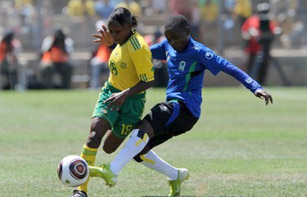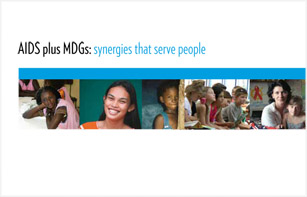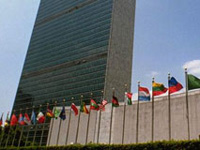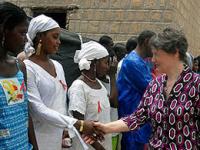Captains of South Africa, Nigeria, France, Paraguay, Uruguay, Australia, Cote D'Ivoire, Uruguay, Greece, and Serbia national teams join appeal to prevent mothers from dying and babies from becoming infected with HIV.

Captain of the South Africa Football Team Mr Aaron Mokoena signing the UNAIDS World Cup Appeal at the Team’s Gala Dinner attended by FIFA President Sepp Blatter, 2 June 2010. Credit: George Philipas
Each day nearly 1200 babies are born with HIV worldwide—during the course of a 90-minute football match almost 80 babies will become newly infected.
Captains of the teams competing in the 2010 FIFA World Cup South Africa may be rivals on the pitch in the coming weeks, but off the pitch they are joining forces to support a global campaign to prevent mothers from dying and babies from becoming infected with HIV.
The initiative is backed by UNAIDS Goodwill Ambassadors and international football stars Mr Michael Ballack, former captain of the German World Cup team, and Mr Emmanuel Adebayor of Togo who have personally asked World Cup football team captains to sign this Appeal:
“Between now and 2014, when the next World Cup is played in Brazil, together we can stop babies from becoming infected with HIV and keep their mothers alive and thriving. Hence we appeal: From Soweto to Rio de Janeiro, give AIDS the red card and prevent babies from becoming infected with HIV.” —World Cup Appeal to prevent mothers from dying and babies from becoming infected with HIV
UNAIDS Executive Director Mr Michel Sidibé, who will attend the World Cup opening ceremonies later this week in South Africa said, “I thank Goodwill Ambassadors Adebayor and Ballack for their leadership. Through the Appeal, the global popularity of football and the prestige of team captains will help us raise awareness about the toll of HIV on mothers and babies and promote action to ensure that HIV testing and treatment services reach all who need it.”
Nigerian team captain Mr Kanu Nwankwo was the first to join up, signing the Appeal in the presence of Nigeria’s President, Dr Goodluck Ebele Jonathan who was guest of honour at the gala send-off dinner for the national team.
Mr Aaron Mokoena, captain of Bafana Bafana, nickname of the host team South Africa, signed the Appeal at a good luck dinner for the team hosted by Kirsten Nematandani, President of the South African Football Association. Mr Joseph F. Blatter, President of FIFA; Mr Issa Hayatou, President of the Confederation of African Football; and Mr Danny Jordaan, CEO of the 2010 World Cup Local Organizing Committee were also in attendance. Cote d’Ivoire team captain and UNDP Goodwill Ambassador Didier Drogba, dynamic striker with Chelsea and top scorer this year in the English Premier League, has also signed.

Nigerian team captain Mr Kanu Nwankwo was the first to join the World Cup appeal, signing in the presence of Nigeria’s President, Dr Goodluck Ebele Jonathan who was guest of honour at the gala send-off dinner for the national team. Credit: UNAIDS
Across the Atlantic Ocean in Latin America, Paraguay’s captain Mr Denis Caniza, and Mr Diego Lugano, the captain of Uruguay are signatories to the appeal. European captains have also signed up, including the team captain of France, Mr Patrice Evra, Mr Giorgos Karagounis, captain of the Greek team, and Serbia’s captain Mr Dejan Stankovic, who discussed the initiative at a press conference last week. Also signed on is Mr Lucas Neill, captain of Australia’s team.
The star players are taking action because in 2008 alone, 430,000 babies were infected with HIV, 90% in sub-Saharan Africa. AIDS-related illness is the single largest cause of death of infants and young children in much on Africa, and the leading cause of death of women of reproductive age across the world.
Countries are however making progress in stemming mother-to-child transmission of HIV. Nearly half of all HIV-positive pregnant women in low- and middle-income countries receive HIV treatment to prevent the transmission of the virus to their babies. These efforts are helping to improve maternal and child health and bring us closer to achieving all the Millennium Development Goals by 2015.
FIFA (International Federation of Association Football) is playing its part in tackling HIV. The Football for Hope Centre in Khayelitsha in the outskirts of Cape Town opened its doors in December, the first of 20 such community centres that will address HIV and other key issues affecting young people across the continent. FIFA will also screen advertisements for condoms and HIV prevention messages at fan parks during the World Cup where fans can view the matches.
“HIV infections in infants have been virtually eliminated in many high-income countries,” said Mr Sidibé. “Now we must apply the tools at our disposal to create an HIV-free generation in Africa and worldwide.”
“We can make change happen in the four years to come—using the power and outreach of the game of football,” states the Appeal. “We can reach out to men and women, families and football fans worldwide to ensure that children do not become infected.”










 The research was supported by a telephone helpline service to respond to health and human rights concerns of sex workers during the World Cup.
The research was supported by a telephone helpline service to respond to health and human rights concerns of sex workers during the World Cup. 

 Captain of the South Africa Football Team Mr Aaron Mokoena signing the UNAIDS World Cup Appeal at the Team’s Gala Dinner attended by FIFA President Sepp Blatter, 2 June 2010. Credit: George Philipas
Captain of the South Africa Football Team Mr Aaron Mokoena signing the UNAIDS World Cup Appeal at the Team’s Gala Dinner attended by FIFA President Sepp Blatter, 2 June 2010. Credit: George Philipas


